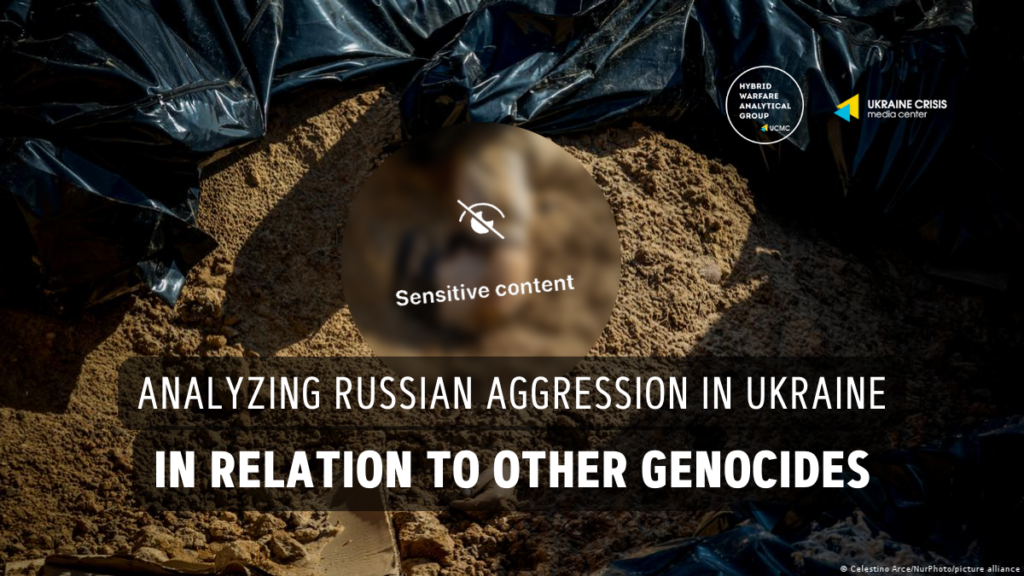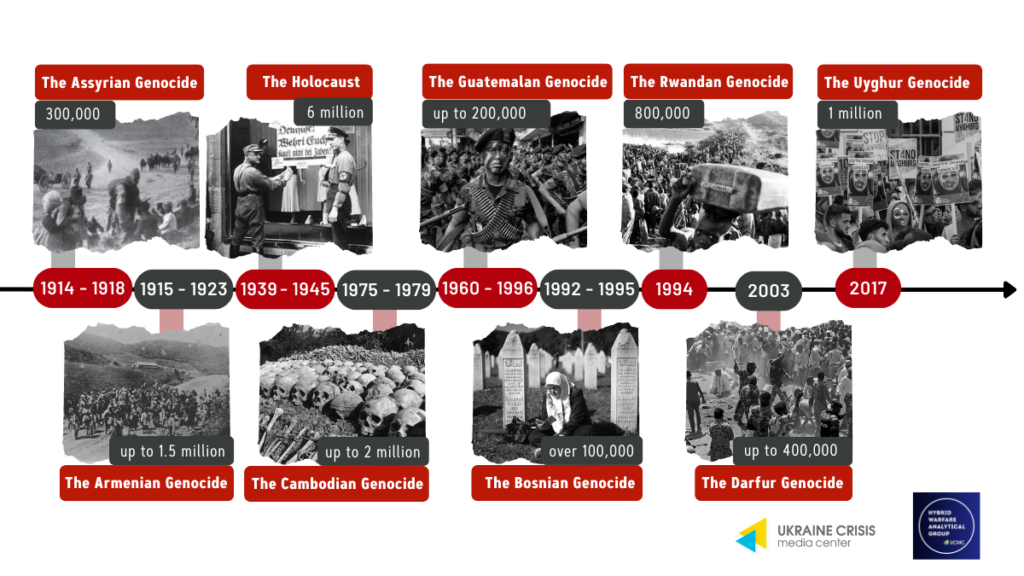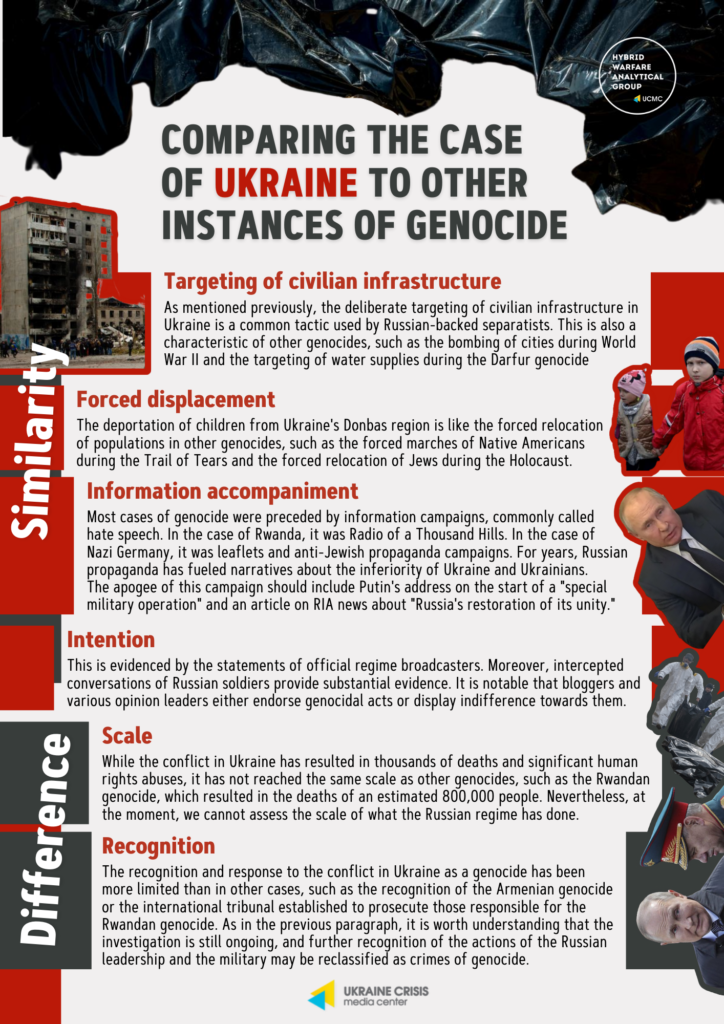
The full-scale Russian invasion of Ukraine is a horrific act of aggression and genocide against the Ukrainian people. This war has led to countless casualties, the displacement of millions of civilians and the destruction of essential infrastructure, resulting in a catastrophic humanitarian crisis. The Russian military has been accused of committing inhumane war crimes and systematic human rights abuses, including ethnic cleansing, extrajudicial killings, torture, and arbitrary detention, with a clear intent to eradicate the Ukrainian population.The situation poses an imminent threat to security and world stability. It highlights the international community’s struggles to prevent and respond to acts of genocide.
In this article, we will delve into the context and root causes of the nature of genocide, the devastating impact on international law, and the legal and diplomatic efforts to hold Russia accountable for its actions.
Chapter 1
Legal Field of Crime
Our journey into the history of genocide should begin directly with its definition. This raises most of the questions given by the international community because there cannot be subjective differences in crimes what is deemed genocide, but discussions, nevertheless, still arise.
Genocide is a term often used to describe the most extreme form of violence against a specific group of people, typically based on their race, ethnicity, religion, or nationality. Raphael Lemkin first coined the term in 1944. He defined it as “a coordinated plan of different actions aiming at the destruction of the essential foundations of the life of national groups, intending to annihilate the groups themselves.”
Since then, various international bodies have adopted legal definitions of genocide. The United Nations defines genocide as “any of the following acts committed with intent to destroy, in whole or in part, a national, ethnical, racial or religious group, as such: killing members of the group; causing serious bodily or mental harm to members of the group; deliberately inflicting on the group conditions of life calculated to bring about its physical destruction in whole or in part; imposing measures intended to prevent births within the group; [and] forcibly transferring children of the group to another group.”
Likewise, the Rome Statute of the International Criminal Court provides a similar definition of genocide. In both definitions, the key elements of genocide are intent on destroying a particular group and the commission of specific acts to achieve that goal.
Nevertheless, the book “Darfur and the Crime of Genocide” indicates the recollections of eyewitnesses that Kofi Annan (former UN Secretary-General) did not want the events in Sudan to be called genocide. A crucial aspect in recognizing specific actions as genocide is the quality and durability of the investigation. Thus, much work is done to prove the fact of genocide: surveys, collection of evidence, and assessment of collateral damage. All this stretches the investigation over time and sometimes leads to distortions in the investigation’s conclusions. However, it is worth noting that there have been cases where accusations over time and the discovery of new facts about the crime raise the bar—for example, the Milosevic tribunal case was raised from crimes against humanity to crimes of genocide.
Chapter 2
The Field of Death
It would seem that if so many factors had caused the genocide, it should not have happened so often, but this is not the case. Only in the 20-21st century were there at least 9 cases that, at least in the public field, can be called genocide. Some of the most notorious cases of genocide include the following:

- The Armenian Genocide: Between 1915 and 1923, the Ottoman Empire, now modern-day Turkey, systematically exterminated up to 1.5 million Armenians. The Turkish government has long denied that this was a genocide, but most historians and scholars agree that it was.
- The Holocaust: During World War II, Nazi Germany orchestrated the systematic extermination of 6 million Jews, as well as millions of others, including Romani people, disabled individuals, and LGBTQ+ individuals.
- The Rwandan Genocide: In 1994, members of the Hutu ethnic group in Rwanda murdered as many as 800,000 Tutsis and moderate Hutus in just 100 days. Long-standing ethnic tensions and political unrest spurred the killings.
- The Bosnian Genocide: From 1992 to 1995, Serbian forces in Bosnia targeted Bosniak (Bosnian Muslim) and Croatian civilians in a campaign of ethnic cleansing. Over 100,000 people were killed, and countless others were displaced or raped.
- The Darfur Genocide: Beginning in 2003, the Sudanese government and allied militias targeted ethnic groups in the Darfur region, resulting in the deaths of up to 400,000 people and the displacement of millions.
- The Assyrian Genocide: During World War I, Ottoman forces targeted Assyrian Christians in what is now modern-day Iraq, resulting in the deaths of an estimated 300,000 people.
- The Cambodian Genocide: From 1975 to 1979, the Khmer Rouge regime in Cambodia targeted ethnic and religious minorities, intellectuals, and others deemed a threat to their rule. As many as two million people were killed through execution, torture, and starvation.
- The Guatemalan Genocide: From 1960 to 1996, the Guatemalan government targeted indigenous Mayan populations, resulting in the deaths of up to 200,000 people. The killings were part of a more extensive campaign of repression against political dissidents and leftists.
- The Uyghur Genocide: Since 2017, the Chinese government has been carrying out a campaign of repression and forced labor against Uyghur Muslims in the Xinjiang region. The government has detained an estimated one million Uyghurs in internment camps and subjected them to forced labor, sterilization, and other abuses.
Chapter 3
Ukraine…
The ongoing war in Ukraine, sparked by Russia’s annexation of Crimea in 2014, has been characterized by numerous human rights cases as abuse and war crimes. Among these abuses, many have characterized Russia’s actions in Ukraine as genocide.
One of the most prominent examples is the shelling of energy infrastructure in Ukraine. Russian forces repeatedly targeted electricity substations and gas pipelines, leaving large parts of Ukraine without power or heat during winter. This deliberate targeting of civilian infrastructure has led to widespread suffering and had a severe impact on the mental health of Ukrainians due to the lack of light and basic everyday living conditions.
Another example is the deportation of children from Ukraine’s Donbas region. Russian forces have forcibly removed children from schools and orphanages, sending them to live with families in Russia without their parent’s consent. This practice has been criticized as a cultural genocide aimed at erasing Ukrainian identity from the region. In the context of the arrest warrant for Putin and Lvova-Belova (the Russian ombudsman for children), we have indisputable evidence of this act’s deliberate and coordinated planning of genocide.
Using a mobile crematorium is perhaps the most disturbing example of Russian actions in Ukraine. In 2022, Russian forces were observed operating a mobile crematorium on the back of a truck to dispose of bodies without a proper burial. Ultimately, they were unable to use them due to massive opposition from Ukrainian society and the military. This method of conducting war has been compared to the Holocaust-era methods employed by Nazi death squads.
These examples, among many others, paint a picture of a conflict characterized by extreme violence and disregard for human life. While the conflict in Ukraine is ongoing, it is essential to recognize the gravity of these crimes and work toward justice and accountability for those responsible.
Chapter 4
Comparing Past Crimes of Genocide
Comparing the case of Ukraine to other instances of genocide, there are some similarities and differences. Here are a few examples:

- Similarity: Targeting of civilian infrastructure – As aforementioned, the deliberate targeting of civilian infrastructure in Ukraine is a common tactic used by Russian-backed separatists. This is also a characteristic of other genocides, such as the bombing of cities during World War II and the targeting of water supplies during the Darfur genocide.
- Similarity: Forced displacement – The deportation of children from Ukraine’s Donbas region is like the forced relocation of populations in other genocides, such as the forced marches of Native Americans during the Trail of Tears and the forced relocation of Jews during the Holocaust.
- Similarity: Information accompaniment – Most cases of genocide were preceded by information campaigns, commonly called hate speech. In the case of Rwanda, it was Radio of a Thousand Hills. In the case of Nazi Germany, it was leaflets and anti-Jewish propaganda campaigns. For years, Russian propaganda has fueled narratives about the inferiority of Ukraine and Ukrainians. This campaign should culminate with Putin’s speech on the beginning of a “special military operation” and an article on RIA news about “Russia’s restoration of unity.”
- Similarity: Intention – This is evidenced by the statements of official regime broadcasters. Moreover, intercepted conversations of Russian soldiers provide substantial evidence. It is notable that bloggers and various opinion leaders either endorse genocidal acts or display indifference towards them.
- Difference: Scale – While the conflict in Ukraine has resulted in thousands of deaths and significant human rights abuses, it has not reached the same scale as other genocides, such as the Rwandan genocide, which resulted in the deaths of an estimated 800,000 people. Nevertheless, we cannot assess the scope of the Russian regime’s actions at this time.
- Difference: Recognition – The recognition and response to the war in Ukraine as a genocide have been less extensive than in other instances, such as the recognition of the Armenian genocide and the establishment of an international tribunal to prosecute those responsible for the Rwandan genocide. As in the preceding paragraph, it is important to recognise that the investigation is ongoing and that the actions of the Russian leadership and military may be reclassified as genocide crimes.
Our Message?
Overall, while there are similarities between the conflict in Ukraine and other instances of genocide, there are also significant differences. Each instance of genocide is unique and shaped by its historical, cultural, and political contexts. However, it is vital to recognize and respond to all instances of genocide, regardless of their scale or recognition, to prevent future cases.
References
1. Steven K. Baum – The Psychology of Genocide_ Perpetrators, Bystanders, and Rescuers (2008, Cambridge University Press)
2. Ronan Lee – Myanmar’s Rohingya Genocide_ Identity, History and Hate Speech (2021, I.B. Tauris_ Bloomsbury Publishing)
3. John Hagan, Wenona Rymond-Richmond – Darfur and the crime of genocide (2009, Cambridge University Press)]
4. Donald Bloxham – Genocide on Trial_ War Crimes Trials and the Formation of Holocaust History and Memory (2003, Oxford University Press, USA)
5. Dinah Shelton, Dinah Shelton – Encyclopedia of Genocide and Crimes Against Humanity Volume 1 (2005, Macmillan Reference)
6. Donald Bloxham (editor), A. Dirk Moses (editor) – Genocide_ Key Themes (2022, Oxford University Press)

